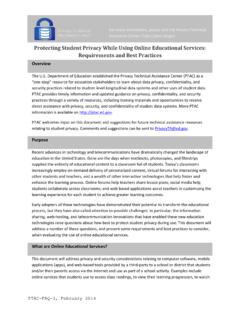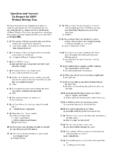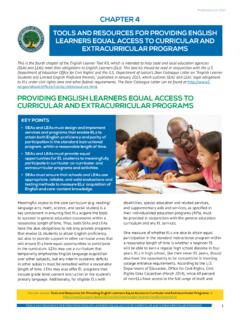Transcription of Distance Learning in Elementary School Classrooms: An ...
1 International Journal of Instruction January 2019 , e-ISSN: 1308-1470 p-ISSN: 1694-609X. Received: 09/07/2018. Revision: 20/08/2018. Accepted: 25/08/2018. OnlineFirst: 04/10/2018. Distance Learning in Elementary School Classrooms: An Emerging Framework for Contemporary Practice Gulnara M. Burdina Elabuga Institute (branch) of Kazan Federal University, Russia, Irina E. Krapotkina Elabuga Institute (branch) of Kazan Federal University, Russia, Liliya G. Nasyrova Elabuga Institute (branch) of Kazan Federal University, Russia, When new advanced technologies showed up in the market, teacher's role in Distance Learning step further in its path to change. Teachers often fail to find what their purpose of acting among technologies is and what the method for teaching Elementary School students online would be right.
2 Considering student's need in communication with a teacher to be at the core of Learning as it is, we define what shape the new curricula will take from year to year. This research is a two-stage experiment with two additional surveys that included 430 students aged 8-9 years from across the Republic of Tatarstan. Students need not only facilitators to get better grades, but also a teacher mentoring them. Student-teacher communication can help students to raise their academic performance and motivation. Questions asked by students in time reduce the number of those who cannot reach their grade level from 9% to 0%, and increase the number of A-level students from 11% to 26%. The results confirm that the on-the-spot teaching method should be introduced into the e- Learning curricula for primary School so that it provides a more intimate communication between the student and the teacher during classes.
3 Results can be put into practical context to create new e- Learning courses for public and private schools. Keywords: Elementary education, Distance Learning , Learning technologies, online education, e- Learning INTRODUCTION. As long as the changes cover all spheres of a person's life, education tends to lag behind in development (Johnson, 2018). Teaching methods simply do not keep up with the world. This phenomenon is most evident in the field of primary education (Altan &. Karalar, 2018). There are several reasons behind this problem. Firstly, the pace of Citation: Burdina, , Krapotkina, I. E., & Nasyrova, L. G. (2019). Distance Learning in Elementary School Classrooms: An Emerging Framework for Contemporary Practice. International Journal of Instruction, 12(1), 1-16. 2 Distance Learning in Elementary School Classrooms: An.
4 Development is more rapid against the slow pace of methods application. Secondly, the approach to assess the information needs and knowledge of Elementary students is wrong. Knowledge and skills that teachers have are out of date. Moreover, in some regions and countries, socio-economic development is at the low level (Oliver et al., 2010). Students far and wide change their life targets. If the previous generation was called the homuter society (homo + computer), then modern students fit the category of mobile homuter society, since they regard mobile phones, ipods and tablets as the main channel for communication and Learning (Rammert, 2012). The pace that technologies took to spread among us has led to the so-called virtualization (Huda et al., 2017). Virtualization is a process when the basic social needs of an individual are met via computers and mobile devices.
5 It generates a completely new phenomenon cyber socialization (Gaol & Hutagalung, 2017). In such a climate, Elementary School teachers have to deal with early virtualization, as students start delving into a virtual world in the preschool period (Opperman, 2016). This becomes a problem because students are forced to change their perception paradigm from a virtual to the real one. Since approaches to preschool education differ from one another, so as the standards of family education, students start School with unequal background. If in one case, parents were fine with virtualization and went for it as for a part of early development, then other parents considered gadgets as an unacceptable element of education (Tcai & Yeh, 2016). In response to cyber socialization and rising significance of computers and mobile devices, more and more schools around the world introduce computer literacy as a separate course that begins since the first days of education (Ng, 2010).
6 Moreover, the current pace of virtualization allows finding new teaching approaches and methods. Distance Learning is one of these approaches that is the most important one. Distance Learning is a Learning system when the teacher and student are separated geographically or technologically (Rogers, 2009). Distance Learning does not imply a completely remote mode. It is often combined with full-time activities that require classroom presence (Rogers, 2009). The rapid technology development, however, allows taking this necessity online. Distance Learning has been actively integrated into the US education system from the very start (through to 1990s). This tool allowed delivering education to those groups of people, who could not attend full-time classes for obvious reasons: students with disabilities, health problems, and students, who lived far from School and had no opportunity to attend it on a daily basis.
7 However, the number of programs was limited back then, and the process had no system behind it (Cavanaugh, 2009). These days, many States have a Distance Learning Development Program that allows experimenting with the way the information is presented, as well as with the interaction options. The list of major tools still has the Internet, specialized programs and video records of lessons and courses on it (Cavanaugh & Blomeyer, 2007). When we argue on the significance of Distance Learning , we refer not only to the system itself, but also to the method of communication applied by the teacher and his/her student. At this point, we have two types of tools to distinguish, more specifically International Journal of Instruction, January 2019 , Burdina, Krapotkina & Nasyrova 3. synchronous and asynchronous communication tools.
8 Synchronous communication is a real-time way for students and teachers to interact at the same time, while asynchronous communication implies interaction in delayed time because of bandwidth gaps that arise from contextual issues. In other words, students have more time for feedback and can file their answers when teachers are off-line (Branon & Essex, 2001). Distance Learning , however, leaves no room for non-verbal communication because it technically achievable only through a videoconference (Neill, 2017). At this point, communication and understanding level down, given that non-verbal signs are considered as an important part of language and reasoning (Kopcha & Alger, 2014). Another important aspect of communication is a channel between the teacher and the parent/tutor responsible for the child.
9 Face-to-face communication is currently considered more effective than its virtual alternative. It allows both participants in the conversation to experience a greater level of trust and understanding between each other. Thus, if real-life communication can be done for any geographical or other reasons, then benefits from communication are least (Al Ghamdi, Samarji & Watt, 2016). The same is true for student-student communication. If some of the Learning material is taught on a real time basis, then students get more motivated to remember things because they feel like the teacher is standing right beside them (Horzum, 2015). Teacher's role remains important even if Learning goes online, as he/she continues to act as a mentor (even if the child has a tutor of his own) (Hern ndez-Garc a, Gonz lez- Gonz lez, 2015).
10 Even those Elementary students, who have been Learning at Distance from the first day at School , have a psychological need to rely on teacher's authority. If the tutor acts totally as a teacher (and if so, then the School only provides the program), then he/she fairly becomes a mentor to the student. Virtual communication between the student and his/her teacher requires a strict line between them so that the child realizes the authority his/her teacher possesses (Imlawi, Gregg & Karimi, 2015). Despite the small differences in organization and approach to Distance Learning , the world experiences are quite similar in general terms. This allows us outlining the main features and advantages of Distance Learning . Distance Learning allows students, who do not have the opportunity to attend School for obvious reasons, to get content knowledge at full scale.

















